The basic picture of the atom that many of us grew up with– that of little electrons orbiting the nucleus like so many planets orbiting the sun –turns out to be a little misleading. Reality is somewhat more complicated: a matter of wave functions, spherical harmonics, and ultimately probability clouds.
The chart above shows the appearance of a single hydrogen atom in a few of its lowest excited states.
In each of those states, the electron is found in a different orbital, some of which have unfamiliar shapes. But even the term “shape” is a little funny for something that you can’t hold in your hand. These are actually probability density plots, which show the likelihood of observing the electron in any one position at a given time– and more correctly, 2D projections of 3D probability densities.
So even the humble hydrogen atom can be a bit complex. Fortunately, we have advanced technology that can help us cut though the quantum mechanical haze: Cookies!
These are atomic spritz cookies, made by taking a fairly common cookie press and outfitting it with custom plates.
It’s not quite a trivial process, but the end result is pretty neat: you get to eat the atomic orbitals.
While there are actually a lot of cookie presses out there, ours is an older Wilton model, which came with the extrusion plates shown above. (All of these disks seem fairly useless, with the possible exception of the electrical ground symbol. Standard cookie press sets should probably also include at least battery, resistor, and capacitor symbols.)
The plates are made of some rigid plastic, and are about 1.95 inches in diameter, and 1/8″ thick at the thickest. Any replacement disks should be of similar size and thickness, quite rigid and strong, and made of food-safe material. Sufficiently rigid, food-safe plastics include delrin, melamine, and glass-reinforced nylon. We suspect that thin bamboo plywood would also work well. A few metals, including stainless steel, would be good choices too.
We ended up locating some melamine dinner plates on sale at the local craft store. Each had a flat section on the bottom, about 1/8″ thick, and we cut our extrusion plates from that material.
Melamine is a funny material. While it’s rigid, it carves easily. Working with it is something like compressed wood, a bit like bone or ivory. Drilling, sawing, and cutting with a hobby knife work very well to shape it. If you like to whittle, you won’t have any trouble working with it.
If you’re not into drilling and cutting these plates yourself, we’d recommend getting your disks made from plastic or wood by one of the popular online laser cutting services (like Pololu, Ponoko), or perhaps using online machine shops (like emachineshop, big blue saw) to cut it out of stainless steel by waterjet– the latter we’d love to try next time we do this.
We drew up the shapes in Inkscape, and here are the disks that we actually ended up cutting, with various sizes and shapes of holes and slits and arcs to approximate the forms in the atomic orbitals that we’re trying to reproduce.
Here’s one of the disks (n, l, m = 3, 2, 1), mounted in the front of the cookie press, held in place by threading on the front ring.
We used the standard recipe for spritz cookies, and dutifully extruded all the different energy levels onto the cookie sheets.
The (4,1,0) cookies came out really well; it’s almost hard to believe that you can just extrude a complex cookie shape like that all at once.
And bake according to the datasheet recipe. Optionally, arrange according to principal quantum number.
If you liked this project, you might like some of our other food projects, including Sierpinski cookies and circuitry snacks.
(If you’ve got a spritz cookie press and need something else to do with it, we also recommend that you check out George Hart’s Trilobite cookies.)





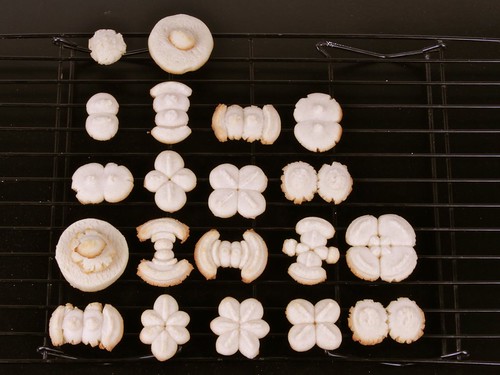
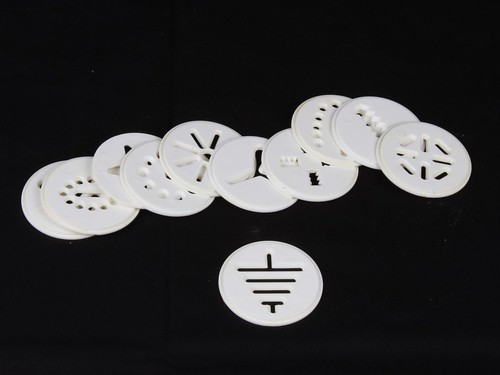
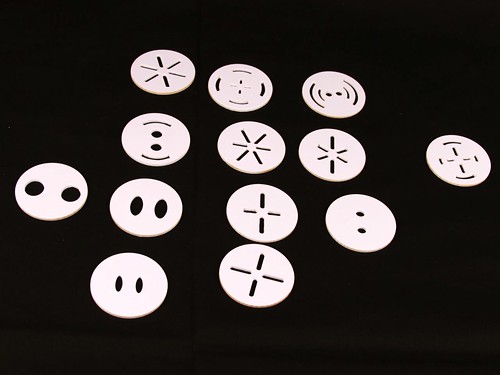
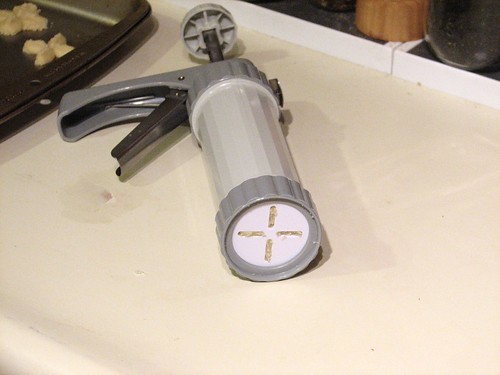
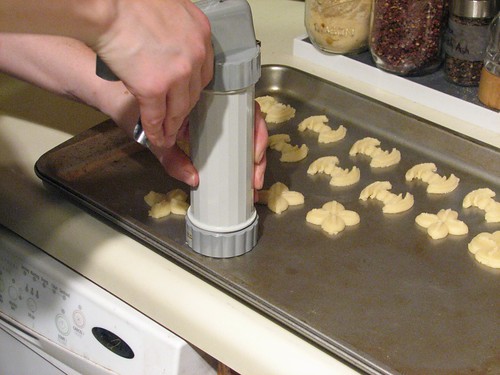
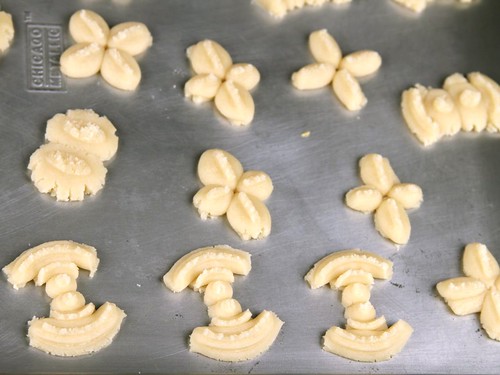

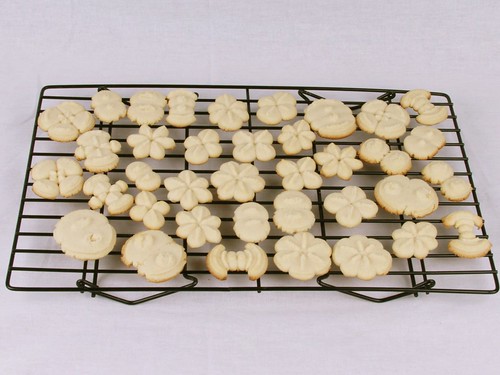
oh, i would totally buy a set of these from you …. !!
As would I! Make up the set, tell me how much, I’ll PayPal you the amt and tell you where to ship them!
I could guarantee at least 5 purchases (just from people in the chemistry department I’ve shown this to) who would buy a set if you decide to sell these.
Were the cookies tasty?
Nice. There is not much that beats eadible geekiness.
Have you considered publishing the plate patterns?
If you squint a tad, one of them looks like batman.
I loved shooting spritz cookies with the electric cookie gun we had when I was a kid. Don’t forget food coloring your cookies. I wonder if you could roll dough with different colors in a millefiori pattern and shoot them?
this deserves to be patented and sold on http://www.thinkgeek.com
think about it!!
How about using "bread dough"/ salt dough/bakers clay instead of cookie dough. Then you could paint them with acrylic paint and make them into necklaces, christmas tree ornaments etc….Twentieth century craft meets Twenty-first century geek!
Woah… and I thought I was a geek by finding Relativity in Java Code!!! o.O Luv the write up!
Any chance you can post the inkscape files?
So like who grew up with "little electrons orbiting the nucleus"? I’m over 50 years old and I grew up (in my junior year of high school chemistry class) with probability clouds and orbitals.
I remember that in elementary school, but I’m probably a few years older than you. (Didn’t get chemistry or physics in high school, so I can’t say if they were teaching it then.)
I’m 56 – we studied the orbital model in elementary school. Those were heady days in science class!
You guys truly are evil!
Yes! You guys are awesome! You had me at spherical harmonics.
I got an A in physical chemistry, by the way.
Actually several look like early stages of embryological development–embryology meets p-chem in the kitchen!
You should post a warning about breathing the melamine dust. FDA thinks it may be hazardous.
I tried those they’re delicioussss
I would like to try this for my chemistry class but I need the template files so that I can cut the plates. Is there a way that they can be sent to me?
I would like to try this for my chemistry class but I need the template files so that I can cut the plates. Is there a way that they can be sent to me?